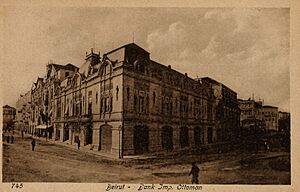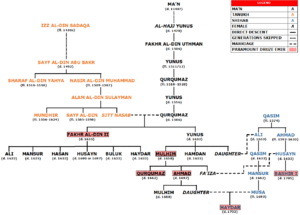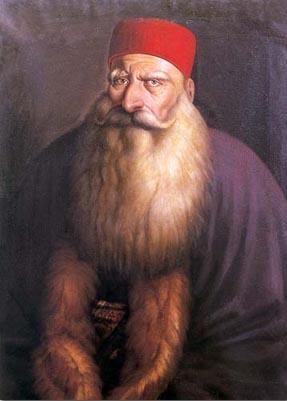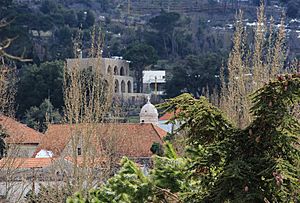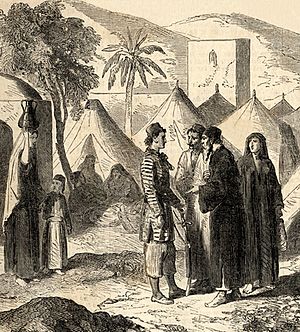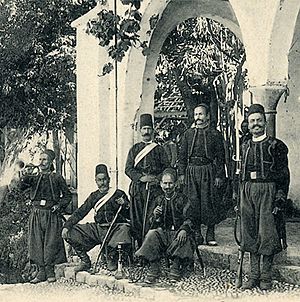History of Lebanon under Ottoman rule facts for kids
The Ottoman Empire ruled Mount Lebanon from 1516 until 1918, which was the end of World War I. The Ottoman sultan, Selim I, took over Syria and Lebanon in 1516.
The Ottomans ruled Lebanon through powerful local families. These included the Maans, a major Druze family, and the Shihabs, a Muslim family that later became Christian. This system lasted until the mid-1800s.
The Ottoman government mostly controlled cities. Most of the country was run by local tribal leaders. These leaders collected taxes for the sultan. This system was like a feudal system. It was called iqta'. In this system, powerful families had a lot of freedom. They were loyal to the emir, who was loyal to the sultan. So, loyalty was very personal.
The Ottoman Empire also gave religious groups some freedom. This was called the millet system. It allowed different religious communities to manage their own affairs. But they still had to recognize the Ottoman government's power.
This system of local rulers helped Bashir II become very powerful. He was an emir from the Shihab family. He ruled Mount Lebanon in the early 1800s. During this time, Bashir II became friends with Muhammad Ali. Muhammad Ali tried to make Egypt rule Mount Lebanon. This period also saw more tension between different social classes and religious groups. These tensions shaped Lebanese life for many years.
Mount Lebanon was divided into Christian and Druze areas. This made people from different groups angry with each other. European countries supported these groups. This led to the terrible massacre in 1860. After this, countries like France, Britain, Austria, and Prussia stepped in. The Ottoman Empire then made changes to how the area was run.
Contents
Ottoman Rule: A Diverse Empire
The Ottoman Empire was very diverse. Many different communities lived side by side. Your religion was very important in how the Ottoman state treated people. While Islam was central to the empire's ideas, being "Ottoman" mostly meant being loyal to the House of Osman.
Local leaders were important because they collected taxes for the Empire. This system was called iqta'. It meant that powerful families served the emir. The emir then served the sultan in Istanbul. Personal loyalty was key. The House of Osman believed the sultan's absolute power was vital. This kept the empire, with its many groups, together. These groups included Ashkenazi Jews, Syrians, Maronites, Copts, Armenians, and other Jews.
These communities had to pay Ottoman taxes. In return, they received religious and civil freedom. However, Islamic law and control were still very strong in society. Christians and Jews were called dhimmis. This meant they were seen as lower, but also protected non-Muslims. They were called "people of the book." Even with some discrimination, non-Muslim groups could use Ottoman courts. They also worked to become self-governing communities. This millet legal system was a key part of the Empire. It helped the Ottomans rule many different peoples by protecting religious communities. Before the 1800s, different groups were not strongly tied to political identity.
Ottoman Conquest of Lebanon
The Ottoman sultan, Selim I, defeated the Safavids and then the Mamluks of Egypt. His troops entered Syria. They crushed Mamluk resistance in 1516 at the Battle of Marj Dabiq, near Aleppo.
Maan Family Rule
After the Ottomans took over, the Chouf area was divided into three subdistricts. These were part of the Sidon-Beirut Sanjak. This Sanjak was a district of the Damascus Eyalet. The Chouf and nearby areas were mostly home to the Druze. Sultan Selim I preferred the Assaf clan. They were enemies of the Ma'nids. He gave the Assafs power in areas north of the Druze Mountain.
The Ma'nid emir, Qurqumaz, was confirmed as chief of the Chouf in 1517. However, some Ma'nid emirs were arrested in 1518. They were released after paying a large fine. This was for supporting a rebellion.

The Ma'nid chiefs likely shared control of the Chouf. Qurqumaz lived in Baruk. In 1523, Ottoman forces burned 43 villages in the Chouf. This was because of unpaid taxes. Druze fighters then killed Ottoman officials. This led to more attacks on the Chouf. The Druze leaders, the Buhturids, then accepted the Ma'nids as their main leaders. In 1545, the Druze leader Yunus Ma'n was executed. This showed that the Druze under Ma'nid rule continued to resist.
After Yunus's death, the Druze bought better muskets from the Venetians. In 1565, they used these new weapons to ambush Ottoman cavalry. The Ottomans were trying to collect taxes. For the next 20 years, the Druze fought off tax collectors. They also gathered more rifles. In 1585, the Ottomans launched a huge campaign against the Chouf. This was led by Ibrahim Pasha. The Ottomans won a big victory. They took thousands of rifles and collected decades of unpaid taxes.
The main leader in the Chouf was Qurqumaz. He was likely the son of Yunus. He refused to surrender to Ibrahim Pasha. He escaped the Chouf but died soon after while in hiding. His death led to chaos and fighting among the Druze.
Fakhr al-Din II's Era
Around 1590, Qurqumaz's oldest son, Fakhr al-Din II, became the leader of the Chouf. Unlike earlier Ma'nid leaders, Fakhr al-Din worked with the Ottomans. The Ottomans could use great force but needed local support to keep peace. When Murad Pasha became governor of Damascus, Fakhr al-Din gave him expensive gifts. Murad Pasha then made Fakhr al-Din the governor of Sidon-Beirut.
The Ottomans were busy fighting wars with Iran and Austria. This gave Fakhr al-Din a chance to grow his power. In 1602, he also became governor of Safed. With the Druze of both Sidon-Beirut and Safed under his command, he became their most important chief.
In 1606, Fakhr al-Din joined a Kurdish rebel, Ali Janbulad. They fought against Yusuf Sayfa, a local rival. Fakhr al-Din wanted more freedom for his region. He also wanted to protect his land from Sayfa. They attacked Sayfa in Damascus. Fakhr al-Din took control of the Keserwan area. When the Ottomans defeated Janbulad, Fakhr al-Din paid Murad Pasha a lot of money. This showed how wealthy the Ma'ns were. Fakhr al-Din kept his governorship of Safed. His son Ali became governor of Sidon-Beirut. The Ma'ns' control of Keserwan was also recognized.

Fakhr al-Din lost favor with the Ottomans in 1611. The Ottomans were now free from other wars. They worried about Fakhr al-Din's growing territory. He had also made an alliance with Tuscany and strengthened his forts. The governor of Damascus, Ahmed Pasha, was sent with a large army to stop Fakhr al-Din. Fakhr al-Din escaped to Tuscany by ship.
A Time of Change and Return
While Fakhr al-Din was away, his younger brother Yunus led the family. The Ma'ns lost their governorships. But Yunus kept the tax farm of the Chouf. In 1615, things changed for the Ma'ns. A new, friendly governor was appointed. Troops were moved away from Syria. Yunus and Ali, Fakhr al-Din's son, got back their governorships.
The Ma'ns then fought their Druze rivals. Ali and Yunus defeated them in several battles. They took back control of Beirut and Keserwan. Ali then gave tax farms to their allies.
Tensions grew between the Ma'ns and their Shia rivals. In 1617-1618, the Shias supported efforts to replace Ali as governor of Safed. But Ali was soon restored to his post.
Fakhr al-Din's Power Grows
The Ottomans pardoned Fakhr al-Din. He returned to Mount Lebanon in 1618. His Druze allies immediately made peace with Ali. Fakhr al-Din then arrested a Shia chief. He released him after a ransom was paid. He also made sure taxes were collected. When some Shia families refused to pay, he destroyed their homes. He later made peace with them.
In 1619, Fakhr al-Din attacked the Sayfa family. He captured their stronghold and other forts. He gained control of the Byblos and Batroun areas. In 1622, Fakhr al-Din helped remove Yusuf Sayfa from power. In return, he gained control of more areas. He also sent his Maronite ally to take over Bsharri. This ended the rule of local Maronite leaders. In 1623, Fakhr al-Din supported Yusuf's rebellious nephew. This made the Ma'ns the main rulers of Safita.
In 1623, Fakhr al-Din removed the Harfush family from Qabb Ilyas. This was because they stopped the Druze from farming there. The Ottomans tried to replace the Ma'ns as governors in some areas. But the Ma'ns soon got their positions back. Fakhr al-Din attacked northern Palestine but was defeated. On his way back, he learned that his sons and allies were reappointed to their posts.
The governor of Damascus, Mustafa Pasha, attacked the Ma'ns. Fakhr al-Din defeated him at Anjar and captured Mustafa Pasha. Fakhr al-Din forced the governor to confirm the Ma'ns' rule. He also gained more governorships. He attacked Baalbek and destroyed its castle. Yunus al-Harfush was executed in 1625. That same year, Fakhr al-Din became governor of Baalbek.
By 1624, Fakhr al-Din controlled most of the Tripoli Eyalet. He captured more fortresses. In 1627, he was appointed governor of Tripoli. By the early 1630s, Fakhr al-Din controlled many places around Damascus. He had 30 forts and a large army. An Ottoman historian said he was almost ready to claim the Sultanate.
The End of Fakhr al-Din's Rule
The Ottoman government sent Kuchuk Ahmed Pasha with a large army to destroy the Ma'nids. Kuchuk first defeated and killed Ali near Hasbaya. Fakhr al-Din and his men hid in a cave. Kuchuk started fires to force them out. Fakhr al-Din surrendered. His sons Mansur and Husayn were already captured. His other sons and relatives were executed. Fakhr al-Din was imprisoned in Constantinople. He and his son Mansur were executed in 1635.
Later Ma'nid Emirs
Ali Alam al-Din, an enemy of the Ma'ns, was given control of the Chouf by the Ottomans. But Mulhim Ma'n, Fakhr al-Din's nephew, had escaped. He led the Druze against Alam al-Din. He defeated him in 1635 and forced him to flee. Mulhim finally drove Alam al-Din out of the Chouf in 1636. Most people in the Druze Mountain supported him. In 1642, the Ottomans made him the tax collector for the Chouf and nearby areas. He held this position until 1657.
After Mulhim died, his sons Ahmad and Qurqumaz fought for power. They faced Druze leaders supported by the Ottomans. In 1660, the Ottoman Empire reorganized the region. They created a new province of Sidon. This was seen as an attempt to gain more control. Qurqumaz was killed in 1662. Ahmad escaped and won the power struggle in 1667. But the Ma'nids lost control of Safad. They only controlled the Chouf mountains and Kisrawan. Ahmad continued to rule until his death in 1697. He had no children. During the Ottoman–Habsburg War (1683–1699), Ahmad Ma'n joined a rebellion against the Ottomans. After his death, the right to collect taxes in Chouf and Kisrawan passed to the rising Shihab family. This was through female family members.
Shihab Dynasty
When Emir Ahmad Ma'n died in 1697 without a male heir, the Druze leaders chose Bashir Shihab I to take over. Bashir was related to the Ma'ns through his mother. She was Ahmad Ma'n's sister. However, the Ottoman authorities did not confirm Bashir's power. Instead, they chose Haydar Shihab, who was Ahmad Ma'n's grandson. Haydar was too young, so Bashir stayed on as a temporary ruler.
The Shihabs now controlled a large area for tax collection. This included Chouf, Gharb, Matn, and Keserwan. But the Shihab emir did not own this land. The Ottomans renewed the tax farm yearly. They could choose to keep the current holder or give it to someone else. The Druze chose the Shihabs because they were not involved in local Chouf rivalries. They also had military strength and family ties to the Ma'ns. Other clans, like the Druze Jumblatts and Maronite Khazens, were smaller tax collectors. They paid the Ottomans through the Shihabs. The Shihabs made Deir al-Qamar their main base. The Shihab emir also had to provide soldiers for the Ottomans when asked. This made the Shihabs the most important social, financial, military, and political power in Mount Lebanon.
In 1698, Bashir protected the Hamade sheikhs from the authorities. He also captured a rebel leader and gave him to the governor of Sidon. As a result, Bashir was given responsibility for "safeguarding Sidon Province." The new governor of Sidon continued a good relationship with Bashir. Bashir died in 1705. Some historians believe Haydar, who was now an adult, was responsible for Bashir's death.
Haydar's Rule
When Emir Haydar came to power, the governor of Sidon tried to reduce Shihab authority. He appointed other leaders as tax collectors. This made things worse for Emir Haydar. In 1709, he was removed from power and replaced by Mahmoud Abi Harmoush. Emir Haydar and his allies fled. Mount Lebanon was taken over by a rival group.
In 1711, the Druze clans worked to regain power. They invited Emir Haydar to return. Emir Haydar and his allies gathered their forces. Their rivals also gathered their forces at Ain Dara. The rivals had support from the governors of Damascus and Sidon. But Emir Haydar attacked first. In the Battle of Ain Dara, Haydar's forces won. The rival leaders were killed, and the Ottoman governors pulled back. Emir Haydar's victory made Shihab power strong. The rival Druze group was defeated and forced to leave Mount Lebanon.
Emir Haydar confirmed his allies as tax collectors. His victory also helped the Maronite population grow. Newcomers replaced the defeated Druze. So, more Maronite farmers became tenants of the mostly Druze landlords. The Shihabs became the main power in Mount Lebanon. They were the top landlords and the main link between local leaders and the Ottomans. The Ottoman governors supported this. The Shihabs also had influence with other local powers. These included Shia Muslim clans and Maronite areas.
Mulhim's Rule
Emir Haydar died in 1732. His oldest son, Mulhim, took over. One of Mulhim's first actions was to punish the Wa'il clan. They had celebrated his father's death. Mulhim saw this as a great insult. He captured their leader, Nasif al-Nassar. Mulhim had the support of Sidon's governor.
In the 1740s, new rivalries appeared among the Druze. One group was led by the Jumblatt clan. Another was the Yazbak faction. In 1748, Emir Mulhim burned properties of some clans. This was a punishment for helping a fugitive. He later paid them back. In 1749, he gained control of Beirut's tax farm. He did this by having a clan raid the city. This showed the city's deputy governor was ineffective.
Struggle for the Emirate
Emir Mulhim became sick. His brothers, Mansur and Ahmad, forced him to resign in 1753. They had the support of the Druze leaders. Emir Mulhim tried to get back control but failed. He died in 1759. The next year, Emir Qasim, Mulhim's son, was appointed. But Mansur and Ahmad bribed the governor and got the tax farm back.
The brothers then fought for power. Emir Ahmad had the support of the Yazbaki Druze. He briefly removed Emir Mansur from Deir al-Qamar. Emir Mansur relied on the Jumblatti group and the governor of Sidon. With their help, he retook Deir al-Qamar. Ahmad fled. Later, the brothers made peace. Ahmad gave up his claim to the emirate.
Emir Yusuf, another son of Mulhim, had supported Emir Ahmad. His properties were taken by Emir Mansur. Emir Yusuf was raised Maronite Catholic but acted as a Sunni Muslim in public. He got protection from Sheikh Ali Jumblatt. Emir Mansur refused to make peace. Yusuf's manager persuaded Sheikh Ali to stop supporting Mansur. Emir Yusuf also gained support from the governor of Damascus. He was given control of the Byblos and Batroun tax farms in 1764.
With these new areas, Emir Yusuf built a power base. He led a campaign against the Hamade sheikhs. This was to support Maronite clans and peasants who were rebelling. Emir Yusuf defeated the Hamade sheikhs. He took over their tax farms. This helped Emir Yusuf against Emir Mansur. It also started Shihabi support for Maronite bishops and monks.
Yusuf's Rule
In 1770, Emir Mansur resigned. He was forced by the Druze leaders. Emir Yusuf took over. This change happened in Barouk village. The leaders signed a petition to the governors of Damascus and Sidon. This confirmed Emir Yusuf's rise. Mansur's resignation happened because he allied with Sheikh Zahir al-Umar and Sheikh Nasif al-Nassar. They were rebelling against the Ottoman governors. Their defeat made Emir Mansur a problem for the Druze leaders. So, they removed him.
Emir Yusuf built ties with the governors of Tripoli and Sidon. With their support, he tried to challenge Zahir and Nasif. But Emir Yusuf faced major defeats in 1771. His ally, Uthman Pasha, was defeated. Emir Yusuf's large Druze force was also defeated. Druze losses were about 1,500 killed. Zahir and Nasif captured Sidon. Emir Yusuf's forces were defeated again. The Russian fleet helped Zahir and Nasif by bombarding Emir Yusuf's camp.
Uthman Pasha appointed Ahmad Pasha al-Jazzar to protect Beirut. Emir Yusuf agreed. But al-Jazzar soon acted on his own. Emir Yusuf asked Sheikh Zahir for Russian help to remove al-Jazzar. After a four-month siege, al-Jazzar left Beirut in 1772. Emir Yusuf made his allies pay for the bribe he gave the Russians. The next year, Emir Yusuf's brother robbed merchants. Emir Yusuf captured his brother's village. He then gained the tax farm for the Beqaa Valley.
In 1775, Sheikh Zahir was killed. Al-Jazzar took over his headquarters. He was soon appointed governor of Sidon. Al-Jazzar wanted to control the Shihabi emirate. He removed Beirut from Shihabi control. He also used divisions among the Shihab emirs to weaken them. In 1778, he sold the Chouf tax farm to Emir Yusuf's brothers. Emir Yusuf paid a large bribe to get the Chouf back. But his brothers challenged him again in 1780. They failed to kill his manager. Emir Yusuf paid al-Jazzar for troops. He also bribed his rivals to switch sides. He again secured control of the Shihabi emirate.
Bashir II's Rule
The most famous Shihab emir was Bashir Shihab II. He was like Fakhr ad-Din II. His skills were first tested in 1799. Napoleon attacked Acre, a city in Palestine. Both Napoleon and al-Jazzar Pasha asked Bashir for help. Bashir stayed neutral. He did not help either side. Napoleon could not conquer Acre and returned to Egypt. Al-Jazzar died in 1804. This removed Bashir's main enemy.
Bashir II decided to break away from the Ottoman Empire. He allied with Muhammad Ali Pasha, who founded modern Egypt. Bashir helped Muhammad Ali's son, Ibrahim Pasha, attack Acre again. This siege lasted seven months. The city fell in May 1832. The Egyptian army, with Bashir's help, also conquered Damascus in June 1832.
During Bashir II's rule, the mountain economy changed. It moved from a feudal system to one based on cash crops. Merchants in Beirut loaned money to farmers. This freed farmers from their feudal lords. It also helped develop a handicraft economy. This led to more trade with France. France became a protector of the Maronites in Lebanon.
In 1840, four European powers (Britain, Austria, Prussia, and Russia) signed the London Treaty. They opposed France's support for Egypt. Muhammad Ali was asked to leave Syria. When he refused, Ottoman and British troops landed in Lebanon. Muhammad Ali retreated. On October 14, 1840, Bashir II surrendered and went into exile. Bashir Shihab III was then appointed. On January 13, 1842, the sultan removed Bashir III. He appointed Omar Pasha as governor. This ended the Shihab family's rule.
Lebanon Under Egyptian Control
After failing to stop the Greek revolt, Muhammad Ali of Egypt wanted control of Syria. He believed Syria was promised to him. But Sultan Mahmud disagreed. Muhammad Ali sent his son Ibrahim Pasha to take Syria. Bashir II had sought safety in Egypt earlier. He became Muhammad Ali's ally. So, he helped secure Egyptian rule in Syria.
During this time, Ibrahim Pasha and Bashir II collected high taxes. This caused resistance. Bashir II's use of Christian forces against the Druze may have caused future religious tensions. Muhammad Ali insisted Bashir II provide soldiers. He even threatened Bashir II when he hesitated. The Egyptian rule also brought social changes. It raised the legal rights of Christians. It also forced people to join the army and give up their weapons.
Religious Conflicts
Conflict in Mount Lebanon (1840)
The relationship between the Druze and Christians has often been peaceful. They have lived in harmony throughout history.
On September 3, 1840, Bashir III became emir of Mount Lebanon. Mount Lebanon is the central part of today's Lebanon. It historically had a Christian majority. "Greater Lebanon," created later, included more areas.
Bitter conflicts between Maronites and Druze, which had started under Ibrahim Pasha, returned. So, the sultan removed Bashir III in January 1842. He appointed Omar Pasha as governor. This caused more problems. In Mount Lebanon, France became friends with Maronite leaders. Britain became friends with Druze leaders. Both communities were still under Ottoman rule. But they saw France and Britain as their protectors.
European powers misunderstood the conflicts. They thought disputes were just old tribal fights. They believed the Ottoman Empire was causing conflict between Druze and Maronites. This was to increase its control. But the Ottoman Empire was struggling to control Mount Lebanon. Britain and France wanted to divide it into two areas: one for Druze and one for Maronites. On December 7, 1842, the sultan agreed. He divided Mount Lebanon into two districts. A Christian deputy governor ruled the north. A Druze deputy governor ruled the south. This was called the Double Qaimaqamate. Both reported to the governor of Sidon. The Beirut-Damascus highway was the dividing line.
This division increased tensions. Druze lived in Christian areas, and Christians lived in Druze areas. Both groups fought for power. Outside powers made the tensions worse. France supported the Maronites. Britain supported the Druze. The Ottomans tried to stir up trouble to gain more control. These tensions led to conflict in May 1845. European powers asked the Ottoman sultan to restore order. He tried by creating a council in each district. Each council had members from different religious groups. They were meant to help the deputy governor.
This system failed. In 1858, peasants in Keserwan rebelled. They were burdened by heavy taxes. Maronite peasant leaders demanded an end to feudal practices. When refused, the poor peasants revolted. They looted and burned the homes of the wealthy.
Mount Lebanon Mutasarrifate
The division of Lebanon into religious communities made the Druze minority unhappy. They complained about their lack of political and economic rights. These issues led to violent religious conflicts. In 1860, about 11,000 Maronites were killed. 100,000 people were displaced. This included Greek Orthodox and Greek Catholics. This gave European powers a chance to step in.
When news of the massacres reached Europe, especially France, there was horror. They called for action to stop the killing of Christians. A series of international meetings, called the Règlement Organique, were held. In July 1860, a conference in Paris agreed to send 12,000 European soldiers to the region. Their job was to "punish the guilty, secure reparations for Christian losses, and suggest reforms." However, Fuad Pasha, the Ottoman official, stopped the violence before the European forces arrived.
On October 5, 1860, the nations agreed on reforms. A new system of self-rule was created. It was called the Mount Lebanon Mutasarrifiyya (governorate). Mount Lebanon was separated from Syria. It gained new freedom under a Christian governor who was not from Lebanon. He was supported by a council of 12 local Lebanese members. These members came from different religious groups.
Mount Lebanon now had special rights not given to other areas. The Mutasarrifiyya did not pay taxes to the central government. People living there did not have to serve in the military. Law enforcement was local. Except for the governor, all officials were local. The official language was Arabic. However, Mount Lebanon had little farmland. It became dependent on nearby areas for food. It also relied on Beirut's port for trade. Ideas to add neighboring areas emerged. These areas, once under Shihabi rule, wanted similar rights.
To control the Mutasarrifiyya's effects, the Ottoman Empire joined the provinces of Damascus and Saida (Beirut) in 1864. This created one large Province of Syria. In 1866, Mehmed Rashid Pasha became governor of Syria. He made reforms to balance the Mutasarrifiyya's impact. Only after World War I did France agree to add nearby districts to Mount Lebanon. This formed the State of Greater Lebanon.
Many Lebanese Christians moved to Egypt, Africa, and the Americas. This was because the Mutasarrifiyya restricted them to the mountains. It was hard to make a living. Money sent back by these Lebanese emigrants still helps the Lebanese economy today.
Lebanon also became a center for learning in the late 1800s. Foreign missionaries started schools across the country. Beirut was the main center. The American University of Beirut was founded in 1866. The French St. Joseph's University followed in 1875. A group of thinkers at this time brought new life to Arabic literature. This new era also saw many publications and a busy press.
This period also had more political activity. The harsh rule of Abdul Hamid II (1876–1909) led Arab nationalists to form secret political groups. Lebanese people found it hard to decide the best political path. Many Lebanese Christians feared Ottoman policies. They worried about a repeat of the 1860 massacres. Some, especially Maronites, thought about leaving the Ottoman Empire. Others, like the Greek Orthodox, wanted an independent Syria with Lebanon as a separate province. This was to avoid Maronite rule. Many Lebanese Muslims wanted to keep the Ottoman system. They liked being connected to the caliphate. But Shias and Druze feared being minorities in a Turkish state. They tended to favor an independent Lebanon or keeping things as they were.
Youssef Bey Karam, a Lebanese nationalist, played a key role in Lebanon's independence.
Arab reform groups hoped the Young Turks would support their goals. The Young Turks had a revolution in 1908–1909. But after gaining power, the Young Turks became more controlling. They gave up many liberal policies. This was due to internal problems and wars. So, Arab nationalists could not count on their support. Instead, they faced opposition from the Turkish government.
Foreign Involvement and Economic Changes
Tensions that led to the 1860 conflict were part of rapid social change. Under Bashir II, Mount Lebanon's farming economy became more linked to Beirut's trade. This changed old feudal duties. It also increased the influence of cash crops. This created stronger economic and political ties with France. France became a protector of the Maronites.
France's connection with Lebanon goes back centuries. French Jesuits arrived in Syria in 1831. In the early 1800s, a strong Christian identity began to form in Mount Lebanon. The Maronite church was key in shaping Lebanon's political history. It helped establish a Christian state in 1920. These Catholic communities built a large Jesuit education system. Université Saint Joseph was founded in Beirut in 1875. The university taught many subjects. This helped students develop a stronger sense of identity. They studied archaeology, language, and history to learn about their homeland. This process strengthened their national identity. These thinkers later called for the country's independence. The knowledge they gained created an elite group. This group later governed the country. They held most government jobs. They also acted as a link between Lebanon and France. They started newspapers and magazines.
This led Britain to support the Druze. They wanted to balance France's influence. They also wanted to prevent separatism that would threaten the Ottoman Empire. Reforms within the Tanzimat also caused more disagreement between Maronite and Druze groups. European powers wanted the Tanzimat to protect Christians. They wanted Christians to have more freedom. But Druze leaders thought the Tanzimat meant they should get back their traditional rights to rule the land.
European countries like England, Germany, and France were very involved in Lebanon. Russia also played a role. Their interactions with the Ottoman Empire led them to operate in Mount Lebanon. In the late 1800s, the Ottoman Empire's economy was failing. The government had to borrow money from European banks. The agreements meant they had to trade with European companies. They also had to let them control parts of their territory, including Mount Lebanon.
The railroad trade is an example of European expansion. In 1888, German companies were given the right to build the Anatolian Railway to Baghdad. In 1889, Germany and France agreed to share ownership of this new railway company. This project, known as the Baghdad Railway, later opened the way for the French mandate. By 1902, French companies controlled five railways across Greater Syria. This included Lebanon, Syria, Jordan, and Israel. At the same time, the Turks gained control of the Ottoman government. They took on more debt. This economic instability led them to sign an agreement in 1914. France agreed to lend the Ottoman Empire money. In return, Turkey gave France rights to build new railways. France also got back all privileges for French charities and religious groups in Syria and Lebanon. This strengthened France's position and helped create the French Mandate later.
World War I and the French Mandate
When World War I started in August 1914, it brought famine to Lebanon. This was mainly due to a Turkish land blockade and confiscations. It killed an estimated one-third to half of the mostly Maronite population over four years.
Turkey joined Germany and Austria-Hungary. It ended Lebanon's self-rule. Djemal Pasha, the navy minister, became commander of Turkish forces in Syria. He had great power. For centuries, the Turks had made non-Turkish people feel alienated. People in the Syrian province became more aware of their own identity. When World War I broke out, these people were willing to help the enemy. They had little sympathy for the Turks.
British and French forces blockaded the Syrian coast. They started intelligence operations with the French. By controlling the waters, the Allies dropped and picked up spies. Local sailors helped spies escape to Allied warships. At night, messages flashed between warships and spies on the coast. These operations were obvious. This pleased many locals and embarrassed the Turks.
Pasha ruled harshly. He executed many people for political activity. This led to mass executions in Beirut and Damascus on May 6, 1916. Lebanon had not seen such violence since 1860. The executions strengthened Arab nationalism. People wanted Arab political independence. The Turkish Army also cut down trees for train fuel or military use. May 6 is now Martyr's Day. Martyrs' Square in Beirut is named after this day.
Ottoman rule in Lebanon ended in September 1918. French forces landed on the Lebanese coast. The British moved into Palestine. This opened the way for Syria and Lebanon to be freed from Turkish rule. At the San Remo Conference in Italy in April 1920, the Allies gave France control over Greater Syria. France then appointed General Henri Gouraud to carry out the plan.
See also
- Mount Lebanon Mutasarrifate
- Turks in Lebanon
- Maronite-Druze dualism


